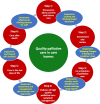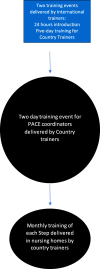A framework for cross-cultural development and implementation of complex interventions to improve palliative care in nursing homes: the PACE steps to success programme
- PMID: 31651314
- PMCID: PMC6814133
- DOI: 10.1186/s12913-019-4587-y
A framework for cross-cultural development and implementation of complex interventions to improve palliative care in nursing homes: the PACE steps to success programme
Abstract
Background: The PACE Steps to Success programme is a complex educational and development intervention to improve palliative care in nursing homes. Little research has investigated processes in the cross-cultural adaptation and implementation of interventions in palliative care across countries, taking account of differences in health and social care systems, legal and regulatory policies, and cultural norms. This paper describes a framework for the cross-cultural development and support necessary to implement such an intervention, taking the PACE Steps to Success programme as an exemplar.
Methods: The PACE Steps to Success programme was implemented as part of the PACE cluster randomised control trial in seven European countries. A three stage approach was used, a) preparation of resources; b) training in the intervention using a train-the-trainers model; and c) cascading support throughout the implementation. All stages were underpinned by cross-cultural adaptation, including recognising legal and cultural norms, sensitivities and languages. This paper draws upon collated evidence from minutes of international meetings, evaluations of training delivered, interviews with those delivering the intervention in nursing homes and providing and/or receiving support.
Results: Seventy eight nursing homes participated in the trial, with half randomized to receive the intervention, 3638 nurses/care assistants were identified at baseline. In each country, 1-3 trainers were selected (total n = 16) to deliver the intervention. A framework was used to guide the cross-cultural adaptation and implementation. Adaptation of three English training resources for different groups of staff consisted of simplification of content, identification of validated implementation tools, a review in 2 nursing homes in each country, and translation into local languages. The same training was provided to all country trainers who cascaded it into intervention nursing homes in local languages, and facilitated it via in-house PACE coordinators. Support was cascaded from country trainers to staff implementing the intervention.
Conclusions: There is little guidance on how to adapt complex interventions developed in one country and language to international contexts. This framework for cross-cultural adaptation and implementation of a complex educational and development intervention may be useful to others seeking to transfer quality improvement initiatives in other contexts.
Keywords: Cross-cultural adaptation; Development; End-of-life care; Implementation; Intervention; Long-term care facilities; Nursing home; Palliative care.
Conflict of interest statement
The authors declared no potential conflicts of interest with respect to the research, authorship, and/or publication of this article.
Figures






References
-
- World Health Assembly. WHA67.19 Strengthening of palliative care as a component of comprehensive care throughout the life course [Internet]. Sixty-seventh World Health Assembly. 2014. http://apps.who.int/medicinedocs/documents/s21454en/s21454en.pdf%5Cn. http://apps.who.int/medicinedocs/documents/s21454en/s21454en.pdf Accessed 29 Nov 2018.
-
- Radbruch L, Payne S. White paper on standards and norms for hospice and palliative care in Europe: part 1. Eur J Palliat Care. 2009;16(6):278–289.
-
- Knaul FM, Farmer PE, Krakauer EL, De Lima L, Bhadelia A, Kwete XJ, et al. Alleviating the access abyss in palliative care and pain relief— an imperative of universal health coverage: the Lancet commission report. Lancet. 2017. 10.1016/S0140-6736(17)32513-8. - PubMed
-
- Swagerty D. Integrating palliative Care in the Nursing Home: an Interprofessional opportunity. JAMDA. 2014. 10.1016/j.jamda.2014.09.008. - PubMed
Publication types
MeSH terms
Grants and funding
LinkOut - more resources
Full Text Sources
Medical

